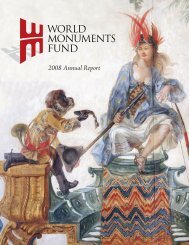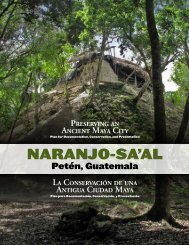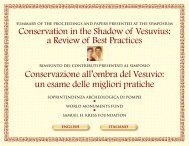Purana Qila and its surroundings (pdf) - World Monuments Fund
Purana Qila and its surroundings (pdf) - World Monuments Fund
Purana Qila and its surroundings (pdf) - World Monuments Fund
You also want an ePaper? Increase the reach of your titles
YUMPU automatically turns print PDFs into web optimized ePapers that Google loves.
4. DarGaH<br />
Opposite Matka Pir, across<br />
Mathura Road, lies yet<br />
another shrine, but with a<br />
very different character to<br />
it. This is the grave of the<br />
17th – 18th century poet<br />
<strong>and</strong> philosopher Mirza<br />
Abdul Qadir ‘Bedil’; known<br />
simply as the dargah (shrine). South of the gate to the National Sports<br />
Club lies a stretch of greenery, mainly scrub <strong>and</strong> trees run wild. This<br />
is known as Bagh-e-Bedil, <strong>and</strong> within this st<strong>and</strong>s the dargah along<br />
with a number of other graves. As you follow the path from the<br />
entrance, you’ll see the green <strong>and</strong> white painted dargah off to your<br />
left. This is a small rectangular structure made of stone (although<br />
you can hardly see the stone because of the paint), with cusped<br />
arches all around—three on the longer sides, one each on the<br />
shorter sides. The arches are supported on slender fl uted Shahjahani<br />
columns. Compared to Matka Pir, the dargah is mostly deserted; very<br />
few people visit.<br />
5. MaTKa Pir<br />
At the south-west corner of Pragati Maidan, opposite the National<br />
Sports Club, is one of the most unusual shrines in Delhi: Matka Pir.<br />
Matka literally means an earthenware water pot, <strong>and</strong> this humble<br />
utensil is very much in evidence all across this shrine.<br />
You’ll see shops selling earthenware matkas as<br />
soon as you enter, <strong>and</strong> as you walk up the<br />
broad marble steps to the shrine, you’ll<br />
notice that the trees alongside are all<br />
festooned with matkas. At the top, beside<br />
the green <strong>and</strong> white painted chamber<br />
that houses the shrine, is a bare tree<br />
laden with even more matkas.<br />
Matka Pir is the burial place of a Sufi<br />
saint, Hazrat Sheikh Abubakar Tusi Haidari<br />
Qal<strong>and</strong>ari, believed to have been a contemporary<br />
of the emperor Ghiyasuddin Balban, who reigned<br />
from 1266 to 1287. The saint’s shrine attracts a large number of<br />
devotees, many of whom come with the prescribed votive offering:<br />
two chaadars (coverlets), gur (jaggery), roasted chana (chickpeas),<br />
sugar, milk <strong>and</strong>—of course—a matka. These matkas are the ones that<br />
eventually end up all across the shrine, making it a l<strong>and</strong>mark with a<br />
very unique character all <strong>its</strong> own.<br />
purana qila booklet.indd 12 27/09/12 3:38 PM
















